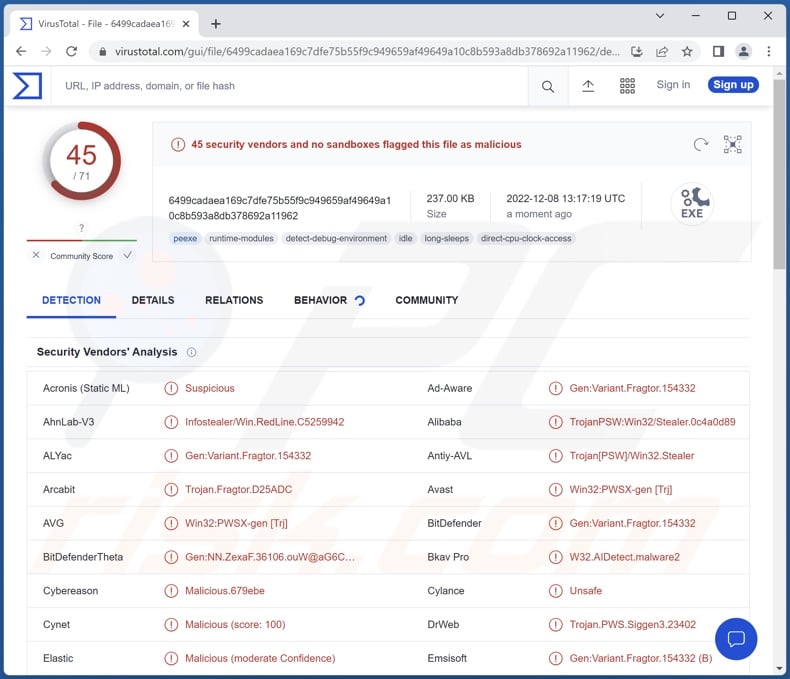Get free scan and check if your device is infected.
Remove it nowTo use full-featured product, you have to purchase a license for Combo Cleaner. Seven days free trial available. Combo Cleaner is owned and operated by RCS LT, the parent company of PCRisk.com.
What is Nosu stealer?
Nosu is the name of a malicious program classified as a stealer. This malware is designed to steal information from infected machines. The Nosu stealer can extract a wide variety of data from devices and installed applications. The most active campaigns associated with Nosu were noted in North and South America, as well as Southeast Asia.

Nosu malware overview
One of the observed Nosu's infection chains began with the Cova loader that infiltrated SystemBC and this stealer into compromised devices.
As mentioned in the introduction, Nosu stealer can acquire a broad range of information from systems and installed apps. This program can download various files.
It also targets browsers, including (but not limited to) Google Chrome, Mozilla Firefox, and Microsoft Edge. From them, it can extract data relating to browsing activity, usernames/passwords, personally identifiable details, and credit card numbers. Nosu can also obtain information from certain email clients, FTPs, instant messaging software, and cryptocurrency wallets.
The vulnerable data could be used to make fraudulent transactions and online purchases, steal the victim's identity and use it for nefarious purposes (e.g., asking online contacts/friends for loans, spreading spam, promoting scams, proliferating malware, etc.).
In summary, the presence of software like Nosu on devices can result in severe privacy issues, significant financial losses, and identity theft.
If you suspect that your device is infected with Nosu (or other malware), we highly recommend immediately using an anti-virus end removing it without delay.
| Name | Nosu malware |
| Threat Type | Trojan, password-stealing virus, banking malware, spyware. |
| Detection Names | Avast (Win32:PWSX-gen [Trj]), Combo Cleaner (Gen:Variant.Fragtor.154332), Emsisoft (Gen:Variant.Fragtor.154332 (B)), Kaspersky (HEUR:Trojan-PSW.Win32.Stealer.gen), Microsoft (Trojan:Win32/Wacatac.B!ml), Full List Of Detections (VirusTotal) |
| Symptoms | Trojans are designed to stealthily infiltrate the victim's computer and remain silent, and thus no particular symptoms are clearly visible on an infected machine. |
| Distribution methods | Infected email attachments, malicious online advertisements, social engineering, software 'cracks'. |
| Damage | Stolen passwords and banking information, identity theft, the victim's computer added to a botnet. |
| Malware Removal (Windows) |
To eliminate possible malware infections, scan your computer with legitimate antivirus software. Our security researchers recommend using Combo Cleaner. Download Combo CleanerTo use full-featured product, you have to purchase a license for Combo Cleaner. 7 days free trial available. Combo Cleaner is owned and operated by RCS LT, the parent company of PCRisk.com. |
Stealer-type malware examples
We have analyzed numerous malware samples; Doenerium, XStealer, and Titan are a few of our newest finds within the stealer category.
This software can have the ability to steal specific data or a broad range of information. Furthermore, malware can have different functionalities in varied combinations. However, regardless of how malicious programs operate – their presence on a system endangers device integrity and user safety. Therefore, all threats must be eliminated immediately upon detection.
How did Nosu infiltrate my computer?
Malware is proliferated using phishing and social engineering tactics. Malicious files can be archives, executables, Microsoft Office and PDF documents, JavaScript, etc. When a virulent file is executed, run, or otherwise opened – the infection process (i.e., malware download/installation) is initiated.
The most commonly used malware distribution methods include: drive-by (stealthy/deceptive) downloads, malicious attachments and links in spam emails/messages, untrustworthy download channels (e.g., free file-hosting and third-party websites, P2P sharing networks, etc.), online scams, malvertising, illegal software activation tools ("cracks"), and fake updates.
How to avoid installation of malware?
We strongly recommend downloading only from official and verified sources. Furthermore, all programs must be activated and updated using functions/tools provided by legitimate developers.
We advise being cautious with incoming emails, PMs/DMs, and other messages. The attachments and links found in dubious/irrelevant mail must not be opened, as they can be malicious and cause infections.
Another recommendation is to be vigilant when browsing since fake and dangerous online content usually appears ordinary and innocuous.
We must stress the importance of having a dependable anti-virus installed and kept updated. This software must be used to run regular system scans and to remove detected threats and issues. If you believe that your computer is already infected, we recommend running a scan with Combo Cleaner Antivirus for Windows to automatically eliminate infiltrated malware.
Screenshot of Nosu stealer's admin panel (image source - BitSight):
Instant automatic malware removal:
Manual threat removal might be a lengthy and complicated process that requires advanced IT skills. Combo Cleaner is a professional automatic malware removal tool that is recommended to get rid of malware. Download it by clicking the button below:
DOWNLOAD Combo CleanerBy downloading any software listed on this website you agree to our Privacy Policy and Terms of Use. To use full-featured product, you have to purchase a license for Combo Cleaner. 7 days free trial available. Combo Cleaner is owned and operated by RCS LT, the parent company of PCRisk.com.
Quick menu:
How to remove malware manually?
Manual malware removal is a complicated task - usually it is best to allow antivirus or anti-malware programs to do this automatically. To remove this malware we recommend using Combo Cleaner Antivirus for Windows.
If you wish to remove malware manually, the first step is to identify the name of the malware that you are trying to remove. Here is an example of a suspicious program running on a user's computer:

If you checked the list of programs running on your computer, for example, using task manager, and identified a program that looks suspicious, you should continue with these steps:
 Download a program called Autoruns. This program shows auto-start applications, Registry, and file system locations:
Download a program called Autoruns. This program shows auto-start applications, Registry, and file system locations:

 Restart your computer into Safe Mode:
Restart your computer into Safe Mode:
Windows XP and Windows 7 users: Start your computer in Safe Mode. Click Start, click Shut Down, click Restart, click OK. During your computer start process, press the F8 key on your keyboard multiple times until you see the Windows Advanced Option menu, and then select Safe Mode with Networking from the list.

Video showing how to start Windows 7 in "Safe Mode with Networking":
Windows 8 users: Start Windows 8 is Safe Mode with Networking - Go to Windows 8 Start Screen, type Advanced, in the search results select Settings. Click Advanced startup options, in the opened "General PC Settings" window, select Advanced startup.
Click the "Restart now" button. Your computer will now restart into the "Advanced Startup options menu". Click the "Troubleshoot" button, and then click the "Advanced options" button. In the advanced option screen, click "Startup settings".
Click the "Restart" button. Your PC will restart into the Startup Settings screen. Press F5 to boot in Safe Mode with Networking.

Video showing how to start Windows 8 in "Safe Mode with Networking":
Windows 10 users: Click the Windows logo and select the Power icon. In the opened menu click "Restart" while holding "Shift" button on your keyboard. In the "choose an option" window click on the "Troubleshoot", next select "Advanced options".
In the advanced options menu select "Startup Settings" and click on the "Restart" button. In the following window you should click the "F5" button on your keyboard. This will restart your operating system in safe mode with networking.

Video showing how to start Windows 10 in "Safe Mode with Networking":
 Extract the downloaded archive and run the Autoruns.exe file.
Extract the downloaded archive and run the Autoruns.exe file.

 In the Autoruns application, click "Options" at the top and uncheck "Hide Empty Locations" and "Hide Windows Entries" options. After this procedure, click the "Refresh" icon.
In the Autoruns application, click "Options" at the top and uncheck "Hide Empty Locations" and "Hide Windows Entries" options. After this procedure, click the "Refresh" icon.

 Check the list provided by the Autoruns application and locate the malware file that you want to eliminate.
Check the list provided by the Autoruns application and locate the malware file that you want to eliminate.
You should write down its full path and name. Note that some malware hides process names under legitimate Windows process names. At this stage, it is very important to avoid removing system files. After you locate the suspicious program you wish to remove, right click your mouse over its name and choose "Delete".

After removing the malware through the Autoruns application (this ensures that the malware will not run automatically on the next system startup), you should search for the malware name on your computer. Be sure to enable hidden files and folders before proceeding. If you find the filename of the malware, be sure to remove it.

Reboot your computer in normal mode. Following these steps should remove any malware from your computer. Note that manual threat removal requires advanced computer skills. If you do not have these skills, leave malware removal to antivirus and anti-malware programs.
These steps might not work with advanced malware infections. As always it is best to prevent infection than try to remove malware later. To keep your computer safe, install the latest operating system updates and use antivirus software. To be sure your computer is free of malware infections, we recommend scanning it with Combo Cleaner Antivirus for Windows.
Frequently Asked Questions (FAQ)
My computer is infected with Nosu malware, should I format my storage device to get rid of it?
No, Nosu's removal does not necessitate formatting.
What are the biggest issues that Nosu malware can cause?
The threats posed by a malware infection depend on the program's abilities and the cyber criminals' modus operandi. Nosu is a stealer – a type of malware designed to extract and exfiltrate sensitive information. Hence, the primary threats associated with these types of infections are severe privacy issues, significant financial losses, and identity theft.
What is the purpose of Nosu malware?
Typically, malware is used to generate revenue. However, cyber criminals can use it to amuse themselves, disrupt processes (e.g., websites, services, companies, etc.), carry out personal vendettas, and launch politically/geopolitically motivated attacks.
How did Nosu malware infiltrate my computer?
Malware is primarily distributed through drive-by downloads, online scams, spam emails/messages, dubious download sources (e.g., freeware and free file-hosting sites, Peer-to-Peer sharing networks, etc.), malvertising, fake updaters, and illegal program activation ("cracking") tools. What is more, some malicious programs can self-proliferate via local networks and removable storage devices (e.g., external hard drives, USB flash drives, etc.).
Will Combo Cleaner protect me from malware?
Yes, Combo Cleaner can detect and eliminate various threats, including most of the known malware infections. It must be emphasized that since sophisticated malicious software usually hides deep within systems - performing a complete system scan is paramount.
Share:

Tomas Meskauskas
Expert security researcher, professional malware analyst
I am passionate about computer security and technology. I have an experience of over 10 years working in various companies related to computer technical issue solving and Internet security. I have been working as an author and editor for pcrisk.com since 2010. Follow me on Twitter and LinkedIn to stay informed about the latest online security threats.
PCrisk security portal is brought by a company RCS LT.
Joined forces of security researchers help educate computer users about the latest online security threats. More information about the company RCS LT.
Our malware removal guides are free. However, if you want to support us you can send us a donation.
DonatePCrisk security portal is brought by a company RCS LT.
Joined forces of security researchers help educate computer users about the latest online security threats. More information about the company RCS LT.
Our malware removal guides are free. However, if you want to support us you can send us a donation.
Donate

▼ Show Discussion